A guide to Ghorepani and Poon Hill Panorama Trekking
Introduction
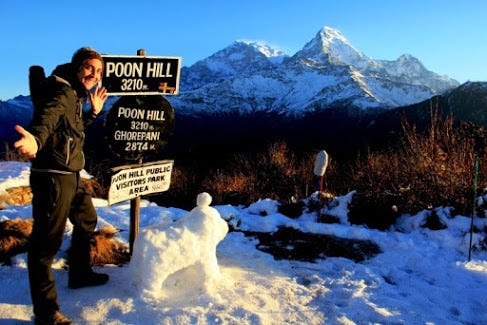
If you’ve got made it to Nepal, there may be a particularly properly risk that you are eager for an epic trekking journey — a superb choice thinking about eight of the world’s 14 The best peaks tower can be discovered here!
We’re association believers that getting into the Himalayas is an exceptional way to recognize this lovely country.
A suitable element of the populace dwells in the small cities dotting the mountain-sides and plenty of the country’s religions, languages, and way of life originate from their valleys and peaks.
Beyond epic views and non-public triumphs, it’s the probability to discover this lifestyle that makes trekking one of the most famous matters to do in Nepal.
For these who have confined time in Nepal however desire to get to the mountains and trip the special Nepalese culture, we can’t suggest the Ghorepani Poon Hill trek (sometimes additionally acknowledged as the Annapurna Panorama Circuit) incredibly enough.
This three-day trek is genuinely a microcosm of what a longer Nepalese mountain trek is like. You’ll skip thru quaint villages, thick jungles and over rivers, and up many, many stairs earlier than subsequently ending up at altitude (3,200m), with your head amongst the tallest mountains in the world.
We hiked the Poon Hill path ourselves recently, and we’re now sharing our insider expertise on excursions and cost, trekking recommendation (including how to do it responsibly!) with you in this exceptional complete guide.
From figuring out which season to trek in, how in shape you want to be, the whole lot you want to understand about trekking permits, what to pack and depart at home, and what the teahouses are certainly like, we’ve bought you covered.
Here’s the entirety you want to understand earlier than tackling the Poon Hill trek yourself!
WHY YOU SHOULD DO THE GHOREPANI POON HILL TREK
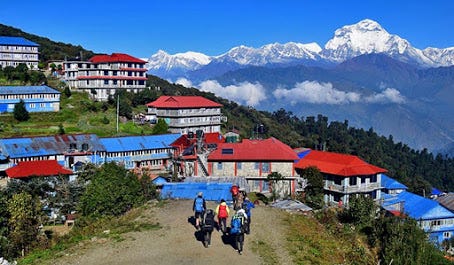
If you’ve solely received a quick time in Nepal however, prefer to see the well-known Himalayan Range and trip Nepal mountain culture, the Ghorepani Poon Hill trek is precisely what you’re searching for.
This three-day trek is really a microcosm of what a longer Nepalese mountain trek is like.
You’ll pass by thru pretty villages and the special neighborhood cultures of the Gurung and Magar communities; up many, many stairs, thru jungles, and over rivers; earlier than subsequently ending up at altitude (3,200m) with your head amongst the tallest mountains in the world.
The views from Poon Hill are some of the great we’ve ever skilled — uninterrupted, panoramic views of some of the biggest and most photogenic Himalayan mountains, together with Dhaulagiri, Nilgiri, Machhapuchhare, Annapurna II, and Lamjung. It additionally occurs to be the spot the place the two of us received engaged — so we can surely vouch for how epic vicinity it is!
It’s gorgeous reachable from Pokhara as the respectable beginning factor is simply 1.5 hours pressure from the lakeside city and at 3–4 days lengthy it truly is the ideal way to ease yourself into trekking in Nepal barring committing to 16+ days on a path (like the Annapurna Circuit!).
What’s more, it’s lower-priced — treks to Poon Hill begin at around USD $240.
POON HILL WEATHER: WHEN TO DO THE POON HILL TREK
The height trekking the season for Poon Hill is between September — November and then March-May.
It’s nonetheless viable to hike in December and January, however, be aware that wintry weather prerequisites will make for an icy journey (temperatures can drop beneath -15c all through height season!), whilst May is the begin of the monsoon season and indicators and make bigger in doubtlessly moist days.
To see the well-known Rhododendrons in full bloom, you’ll need to do the hike in April, and we sense this is the exceptional time to trek Poon Hill, as the views are stunning, and the climate comfortable.
We trekked at the give up of May (May 23–25 to be exact!), and have been great fortunate with the weather. It was once warm via the morning and early afternoon, however, by using the time we reached our teahouse in the late afternoon/evening, the heavens would open with a massive downpour that cleared the warmness away.
The temperatures have been slight ample that we didn’t want a napping bag (though you genuinely would in the course of height season).
We had been additionally talented crisp, best dawn views at the summit point, which was once-perfect thinking about that’s additionally the ridiculously ideal spot Mark selected to pop the query at.
NOTE | If you favor to whole Poon Hill as a section of a longer Annapurna Circuit or Annapurna Base camp trek, you’ll want to stick to the top trekking instances for these (October to early December, then February thru to April) as heavy snow or monsoonal rains stop trekking in the greater reaches of these trails outdoor height season.
SHOULD YOU TREK POON HILL SOLO OR WITH A GUIDE?
A fierce debate rages amongst these who come to Nepal for an epic trekking adventure: must one trek in Nepal with a prepared group, or absolutely heave on a rucksack full of your equipment and take to the trails alone?
We agree with each pick is definitely attainable here, and like anything, everyone has its personal special benefits and disadvantages.
There are lots of humans who choose to trek solo in Nepal, and it certainly is a flawlessly manageable feat.
Personally, we’ve solely ever opted to take a guided tour right here (more on that below), even though now that we have a few hikes and trips beneath our belt, we may additionally, think about going solo subsequent time.
TREKKING POON HILL SOLO
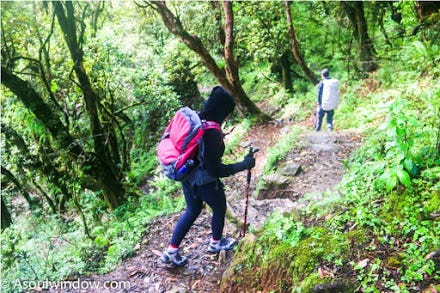
Due to being a shorter trek inside the famed Annapurna region, Poon Hill is one of Nepal’s greater famous trekking routes — which are ideal if you’re a solo trekker in search of an adventure!
THE PROS
Freedom
- take the path at your personal pace, end the place you prefer barring having to account for everyone else.
Affordability
- trekking solo can regularly be more cost-effective than reserving via a tour company
Best of each world
- you can hike solo thru the day, and nevertheless revel in a terrific crew environment at the teahouses every night
THE CONS
You’re accountable
-Planning your itinerary, organizing your personal permit, accommodation, food, and gear; no one has your lower back however you… consisting of in the course of the top season when all of the lodgings are booked up weeks in advance!
Lack of understanding
- You won’t have a skilled expert round to assist hold you on the proper track, pick out any doubtlessly unsafe areas or altitude-related troubles (although Poon Hill is a lower altitude trek, so you have to be qualified in this area).
Missing out
- One of the biggest advantages of having neighborhood information is having anyone who can share their expertise about lifestyles in Nepal, Nepalese lifestyle and language, and nearby flora. Some of our favored conversations with locals have come about with our courses on hikes in Nepal!
Safety
- Nepal is notoriously pleasant and welcoming, however, as with any USA in the world, there are positive dangers worried about going it alone. In the latest years, there have been situations of solo trekkers disappearing on trails, and whilst these are normally few and some distance between, it’s well worth bearing in mind. Female hikers: we’d additionally suggest visiting with a friend, or lady information and porter to keep away from any achievable harassment.
HIKING POON HILL WITH GUIDE AND/OR A GROUP
There are two methods to take a guided tour in Nepal; both can employ a piece of information simply for yourself and your trekking friends or be a part of an equipped tour.
While we love ourselves a solo ramble in nature most of the time, this is clearly our favored way to hike in Nepal, for the following reasons:
THE PROS
Everything’s geared up for you
- No want to fear about matters like organizing your allow earlier than your trek, reserving teahouse accommodation, or planning your itinerary — it’s all taken care of for you.
Local specialist know-how
-You constantly have a neighborhood pal to share their specialist knowledge, hold you on the proper track, administer first aid, or train your new Nepali words.
Porters
- Most prepared excursions additionally consist of a porter, who will lift your heavier tools alongside the path for you.
Community empowerment
- Trekking with information empowers the neighborhood — mainly if you’re reserving with an on-ground nearby operator — and to unfold wealth amongst the guides, porters, and on-ground staff.
Ready-made cheer squad
- Having other humans to aid and be supported with the aid of is a splendid factor when you’re feeling worn-out and breathless on that last morning hike up to the summit!
THE CONS
The price
- This choice can be extra steeply-priced than going it by myself — however we variety of experience that this is one time the place the advantages outweigh the costs
Lack of flexibility
- If you are used to unbiased travel, be sure to any individual else’s graph (and crew personalities) may be a shock to commence with!
TREKKING PERMITS AND TIMS PASSES FOR THE POON HILL TREK

Whether you pick out to trek Poon Hill solo or with a group, you’ll want to have each a Trekking Information Management System (TIMS) permit, and an Annapurna National Park Permit (sometimes additionally recognized as the Annapurna Conservation Area Permit).
If you are trekking with an organized tour group, the price of these will be included in your trekking price and the complete system (organizing them and carrying them thru the trek) will be managed by using your guide.
For trekkers going it alone, the lets in will set you returned about USD $40–50.
The ACAP Permit is USD $3,000 / NPR 3,000 per person, whilst the TIMS Permit is USD $20 / NPR 2,000 per person. You’ll want to elevate these lets in with you at all instances on the trail, as they’ll be checked at a variety of checkpoints alongside the way.
Trekking lets in can be organized both at the Nepal Tourism workplace primarily based in Kathmandu, or the Pokhara traveler workplace earlier than you commence the trek.
Make certain you carry a minimum of four passport pictures for the trekking allow too!
HOW MUCH DOES THE POON HILL TREK COST?
Treks to Poon Hill are additionally wonderful low priced in contrast to some of the longer treks in Nepal.
We paid $240 (USD) per person, which appears to be around the beginning factor for guided treks; though this is very an awful lot established upon what time of 12 months and who you e-book with too!
Included in the price of our tour was once the following:
• Accommodation
• 3 foods per day + tea/coffee breaks
• Guide
• Porter
• Taxi from Pokhara to Nayapul for the begin of the trek
• Taxi lower back to Pokhara at the cease of the trek
• ACAP Permits + TIMs registration
Trekking solo / beside information will for sure be pretty a bit much less as you’re now not paying information and porter wages, however, you will have to manipulate your lets in + trek corporation yourself.
We’d propose budgeting someplace round $40–60 per person, per day if you’re planning to go solo (and in all likelihood greater in top season).
NOTE: You’ll additionally have to pay an NPR a hundred entrance rate at the Poon Hill gate, so don’t neglect to slip some money in your pocket for the summit morning!
GHOREPANI POON HILL TREK | THE FULL ITINERARY FOR NEPAL’S BEST SHORT TREK
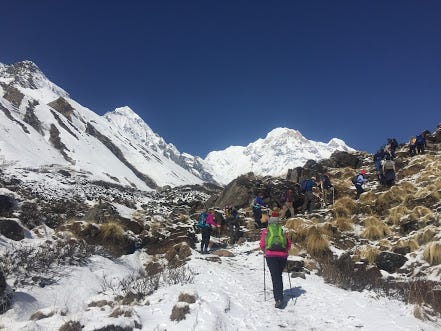
The Poon Hill trek is formally listed as a 4–7-day trek, due to the fact it definitely relies upon how tons time you prefer to spend in the mountains and the route you desire to take.
One of the most famous routes take you from Nayapul to Ghandruk; we opted for Nayapul to Nayapul (actually, technically we completed in Bantanthi as that’s the place the auto gathered us).
We did the trek in two nights, three days, and felt this used to be a definitely plausible feat, even though descending the whole way down the stairs in one day clearly became our legs to jelly (and had us on foot humorous for a whole week after!).
If you do have greater time and flexibility than we did, we’d truly advocate the 5-day hike choice that takes you via Tatopani and Ghandruk on your way again to Pokhara.
Here’s what our Poon Hill trek itinerary appeared like:
POON HILL TREK ITINERARY DAY ONE | POKHARA TO TIKHEDUNGA (VIA NAYAPUL, THE START OF THE TREK)
Starting factor | Nayapul (1070m elevation)
Finish factor | Tikhedunga (1580m elevation)
Total ascent | 540m
Distance trekked | ~10 km
Time trekking | 3–4 hours
The 1.5-hour vehicle the journey from Pokhara to the trek’s legitimate (and most popular) beginning point: Nayapul.
Nayapul is a gorgeously quintessential Nepalese rural trekking town; layers of farmland carve the decrease mountain slopes surrounding the town, whilst the predominant road is abuzz with activity.
Mothers collect on steps making an attempt to tame their children’s hair, guys sit down and chat in the city center. A consistent circulation of trekkers makes their way via smiles and nods to every other, and there’s simply a trace of the journey in the air.
We move a suspension bridge and have our Permits and TIMs card checked at the Bantanthanti checkpoint earlier than opening the 3-hour trek to our domestic for the evening: Tikhedunga.
The stroll is peaceable and follows the Bhurungdi Khola River thru peaceable farming villages and lush mountain valleys.
Every now and then a jeep bounces previous on the filth road, ferrying travelers greater up to the city of Hille (the furthest factor you can get by way of auto on the Poon Hill trail). So far, the sluggish ascent is definitely manageable, though our unfit our bodies are really feeling it.
We cease for a (delicious) veggie noodle soup lunch in Lambdawi. The day is already warm and humid, so it’s returned on the path quickly for the closing 1.5-hour hike into Tikhedunga.
From here, the ascent is steep, though the quaint villages, lovely Himalayan mountain dogs, and stunning surroundings truly make up for it. Eventually, we arrive at Tikhedunga proper as monsoon storm clouds start to roll in.
Our lodging Tikhedunga Guest House, proper at the give up of the village. Comfortable, pretty, and proper beside three waterfalls, it’s a peaceable oasis we’d, fortunately, remain in for days.
Dinner is Thukpa, Momos, clean fruit, and masala chai earlier than heading to mattress via 8 pm to the sound of rain on the roof.
POON HILL TREK ITINERARY DAY TWO | TIKHEDUNGA TO GHOREPANI
Starting factor | Tikhedunga (1520m elevation)
Finish factor | Ghorepani (2853m)
Total ascent | 1360m
Distance trekked | ~12km
Time trekking | 7.5 hours
The alarm sounds at 6 am, and we groan a little. Today’s the day we (and likely everybody else on the Poon Hill trek) dread: the notorious 3,000-step climb from Tikhedunga to Ulleri. We begin early to keep away from the searing warmness of the day, however via 8 am it’s already stinking hot.
‘Bistari, bistari,’ (slowly, slowly) reminds Riddhi, though the burning in our legs suggests shifting any faster isn’t a choice anyway…!
We share the direction with different trekkers and the extraordinary herd of horses being moved between towns. Finally, we attain Ulleri, and whilst the stairs may also have ended the common ascent without a doubt hasn’t, and we’re solely about midway to our closing stop.
In Banthanti, we quit for a clean lemon mint juice (NPR 300) and to relax whilst taking in some of the views for 20 blissful minutes. Being again in the mountains is the whole lot proper now!
The landscapes trade dramatically from here; thick forest, moss-covered bark, inexperienced ferns, and flowing waterfalls. After a few months of huge metropolis travel, the sparkling air and natural surrounds are precisely what our bodies crave.
At over 2,300m elevation and rising, matters are beginning to sense a little tougher, although whether or not it’s the moderate altitude, our questionable health levels, or both, we’re now not sure!
Lunch in Nagethanti can’t come quickly enough, and when it does, it’s the great veg noodle soup (Thukpa) we’ve had: wealthy and tomatoey with a trace of chili.
From there, it’s sluggish and consistent trekking thru some stunning Rhododendron forests over 200 years old. They’re no longer in bloom, however, they’d be magical in April.
Our first glimpse of Ghorepani offers us a 2nd wind, and when we sooner or later arrive at our guesthouse, 7.5 hours after leaving Tikhedunga, the alleviation is real.
POON HILL TREK ITINERARY DAY THREE | GHOREPANI TO POKHARA (900m) VIA POON HILL SUMMIT
Starting factor | Ghorepani (2853m)
Finish factor | Pokhara with the aid of Poon Hill (3210m) and Nayapul
Total ascent | 357m
Total descent | 2140m (to Nayapul)
Distance trekked | ~24km
Time trekking | ~10 hours
Given what befell simply a few hours later (our engagement!), our summit morning is definitely a little bit of a blur… however, what we do be aware of is that at 4:30 am, we virtually bounce out of mattress and race to the window to test the sky.
Last night's time was once ominously gray and foggy. This morning is, thankfully, clear and crisp.
We’re on our way about 10 minutes later, geared up for the remaining 45-minute hike to the Poon Hill summit. Pre-dawn mountain mornings like these are our favorite: stars above, the quiet calm of a new day, and the anticipation of sooner or later attaining a purpose you’ve been working tough for.
It’s steeper than predicted and about midway via we go the notorious 3,000m mark: the magic the factor you have a tendency to begin feeling the altitude.
Breathing turns harder, the burn in our legs greater intense, however, we’re excited understanding it won’t be too many further. We attain the entrance gate soon and pay the one hundred rupee entrance price (don’t forget about your wallet!).
The world is beginning to wake with a pinky glow as we sooner or later attain the crest and are greeted by the most attractive sight imaginable: the mountains of Dhaulagiri, Nilgiri, Machhapuchhare, Annapurna II, and Lamjung laid out proper earlier than us, illuminated by using the sunrise.
Somewhere nearby, a fellow hiker has one way or the other carried his guitar up and is now serenading us all with some acoustic faves.
It’s the variety of second, you prefer to bottle up and maintain forever, and we weren’t certain existence may want to get any higher than this…. until, of course, Mark set up our tripod and digital camera as a decoy then dropped to one knee and proposed!
Once we’d calmed down sufficient to suppose about getting ourselves off the mountain again, it was once time to head lower back to Ghorepani for breakfast (chocolate pancakes for the win!).
From there, we had to retrace the daunting 24km trip proper lower back to our beginning point. If we’d concept trekking up 3,000 stairs used to be a difficult gig, trekking down them used to be pure torture.
After descending/stumbling/falling down the 3,000 stairs, we finally made it again to Tikhedunga for lunch (and to name our households with our thrilling news!) earlier than trekking on once more to Birethanti the place our automobile was once ready to ferry we again to our hostel in Pokhara again.
POON HILL TREK DIFFICULTY | DO YOU NEED TO BE SUPER FIT TO TREK POON HILL?
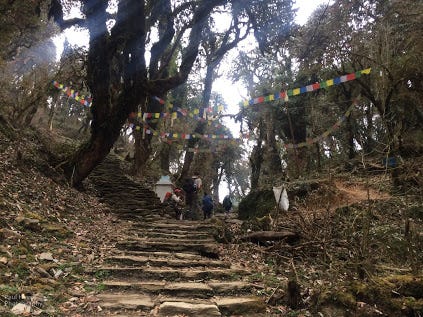
We’re sincerely now not in the high of our health proper now, however, the two of us had been in a position to whole the Poon Hill trek flawlessly fine.
This is classed as an easy-moderate trail, and as it starts off evolved and ends at quite a low altitude there aren’t too many bodily requirements.
That said, whilst an average stage of health is great you’ll want to be capable to manipulate being on your ft for 4–6 hours a day for a few days in a row, and make certain you’re fantastic with stairs and steep hills.
On the subject of stairs though: be organized to stroll up and down plenty and plenty and a lot of the little buggers!
There are over 3,500 stairs from Tikhedunga to Ghorepani, all exclusive heights and shapes, which make for a painful day trekking up, and an even extra knee-crunching day when you have to address them on the descent.
Regardless of the trek difficulty, continually make positive your journey with to date journey insurance plan in case you slip and harm yourself, or the sudden happens. We tour with World Nomads.
WHAT’S THE ACCOMMODATION LIKE ON THE POON HILL TREK?
We’ve included the whole thing you want to be aware of about lodging in Nepal in this post, however briefly: the teahouses speckled alongside the trekking trails aren’t the Shangri-La, however, they are charming little matters made from stone and wooden and comfortable vicinity to loosen up at the quit of a lengthy day’s trekking.
Generally, rooms are twin-share, with extra than adequate house to unfold out.
Most have separate bathe and look amenities — though our teahouse in Ghorepani had an ensuite replete with warm showers! — And there’ll additionally be communal vicinity that doubles as an eating corridor with both fire and boiler to satisfy up subsequent to of an evening.
It’s additionally enormously regular to devour your nighttime meal at the identical teahouse you’re staying at, and they’ll typically ask you to order your meals as you take a look at it.
In phrases of charging your gear, there are common spots to cost in the communal space, and you can also want to pay a small price to use these.
FOOD ON THE POON HILL TREK (IS DELICIOUS!)
We essentially lived off veggie Thukpa (noodle soup) in the course of our trek as it’s one of our preferred Nepalese/Tibetan dishes, however, you’ll locate a notable combination of Nepali and Continental meals alongside the trail.
Better yet, the meals are natural and grown in the hills surrounding the nearby communities, so it’s fantastically clean and precisely the sort of nourishment you want for your trek.
Honestly, we haven’t had a terrible meal in the mountains and there are days we dream about sitting backyard on a crisp sunny day and playing a lovely Nepali feast.
You’ll locate fees will make bigger the greater you climb, however, anticipate to pay around NPR 500 for Dal Baht, NPR 300 for a bowl of Thukpa, NPR 200 for soups, and NPR 450 (veg) — 600 (meat) for a tasty plate of Momos.
IS THE POON HILL SUNRISE WORTH IT?
Most humans layout their trek so that they ascend Poon Hill in the pre-dawn and watch the solar upward shove over the mountains in the front of the lookout.
But is it actually well worth the early start?
Uhh… YES. Just seem to be at the photograph below!
Take it from this non-morning person; this is one early begin you surely favor to get up for.
While we’re tremendously positive that the views would be epic at any time, looking at daybreak over the Annapurna varies and some of the biggest mountains in the world are a humbling, awe-inspiring journey we won’t be forgetting any time soon.
RESPONSIBLE AND SUSTAINABLE TREKKING IN NEPAL
We definitely have full information for how to trek responsibly in Nepal here; however in the meantime, right here are a few pointers particularly for your Poon Hill trek:
Don’t help the horse/donkey rides | Please, simply don’t. The paths are terribly unstable for hooves, and many a horse we encountered regarded worse for wear.
Bring a reusable water bottle | There is no want for a current traveler to purchase bottled water, ever. Purchase a water filtration + purification bottle (like our faves from The Grayl) and you will actually in no way want to buy bottled water again.
ACAP additionally grants UV filtered water stations for consuming water all alongside the trail.
Replace bottled drinks with cans | No factor skipping the bottled water if you decide for smooth drink or juice in a plastic bottle too. Switch to the canned range alternatively (always offered on the trail).
Trek at the tail ends of the season: Trek both aspect of the height durations to keep away from contributing to over-tourism and environmental degradation
Respect the nearby subculture: The Annapurna place is domestic to some of Nepal’s most special lifestyle and customs.
The show appreciates for the web sites and communities right here by way of behaving with respect: costume accurately (ladies, leggings are higher than shorts!), don’t litter and make an effort to chat with locals about their way of lifestyles and beliefs
Don’t barter for your lodging: Remember that your potential to come to Nepal and trek (even on a backpacker budget) is a proper privilege; don’t barter nearby teahouse operators for free lodging in change for ordering meals and drink instead.
Support the neighborhood communities reliant upon neighborhood tourism for survival instead.
Don’t hand out items or cash to children on the trek: It actively encourages begging, which maintains children out of college and fuels begging mafia who recruit susceptible youngsters to work for them.
Limit your plastic consumption: Many villages don’t have ample waste disposal strategies and have to both make the preference between burning it off or carrying it off the mountain themselves.
Where possible, keep away from plastic altogether on your trek, and if you can’t, elevate it out of the park with you.
Pick up any trash you see: If you come through garbage on your trek, accumulate it in a tote bag and take it off the trails with you to dispose of proper later.
OUR POON HILL TREK PACKING LIST
Preparing what equipment to take for a trek like this is in reality a problematic act; it is all about discovering the stability between packing as mild as possible, whilst nevertheless maximizing the equipment that you do take.
Not that we did our trek in the hotter months, so we have been capable to pack pretty light. If you’re trekking in winter, we’d advocate including a few hotter layers too.
Here’s what we took our trek (and definitely recommend):
Travel insurance plan | You guys understand the drill; if you can’t come up with the money for journey insurance, you can’t manage to pay for to travel. We use World Nomads, get your quote here.
Sturdy trekking boots | We love our Danner Boots, however, if you desire something lighter, strive for these water-resistant trekking boots
Comfortable daypack | We use the Fjallraven Abisko Hike 35L daypack and we clearly love it.
Reusable water bottle | We use the Grayl GEOPRESS each day, each day trip we take!
Dry bag | Sea to Summit’s dry bag vary will preserve your clothes, electronics, etc. secure and dry, in particular, round moist season!
Packing satchels | If you pick out to trek with a porter, your packing satchels will go into their larger bag
Lightweight down jacket | Even in the hotter months, you’ll want a first-rate jacket (women’s jacket here) for the summit
Bottoms | two pairs of pants/leggings, (one for trekking, one for evenings), 1 pair of shorts
Tops | Enough t-shirts/tops to final you three days of intensive hiking!
Light jumper | Mostly for the evenings
Waterproof jacket | If you’re trekking in the warmer, monsoonal months, make certain you have a water-proof jacket on-hand. We noticed masses of very sorry-looking moist humans in the afternoons!
Portable charger | you need to be capable to cost your tools at Teahouses, however, to keep away from having to queue for it throws a transportable charger in your bag
Your digicam | obviously! Check out our full listing of images tools here
A FEW OTHER USEFUL THINGS TO KNOW ABOUT THE POON HILL TREK
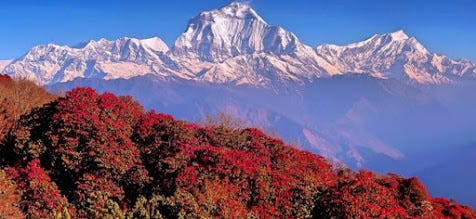
Accessibility isn’t incredible | You can get jeeps all the way up to Hill and trek from there. That said, regrettably, this trek is honestly no longer for these with mobility or accessibility issues; it’s steep, uneven and at times, slippery.
Staying linked | 3G is accessible in Tikhedunga, however, in any other case you’ll conflict for reception alongside the relaxation of the trail.
Wi-Fi is accessible in most teahouses for a small price (100–200 rupees relying on the village/guesthouse), for the duration of the late afternoon/evening when the photovoltaic kicks in. It tends to be a great patch and solely constrained to frequent areas.
The standard rule is: Don’t count on it, and actually don’t anticipate it!
Don’t count on warm bathe | Most teahouses promote 24-hour warm water, however no longer all definitely stay up to that statement. You can, however, get a warm bath at some point of the day (solar), or if a fuel alternative is available. Enquire about your accommodation!
Bring snacks from Kathmandu | Prices get steeper the greater you go, so purchase any trekking snacks (and your summit chocolate!) in Pokhara earlier than you depart.
Get your espresso repair at the summit | what’s higher than summiting? Drinking a warm espresso or chocolate at the top! There’s a stand up there with (expensive) warm drinks for sale. Don’t take your personal thermos — there’s additionally a hefty great if you’re caught with one.
Start early | We noticed lots of solo trekkers trying the massive stairs day (Tikhedunga to Ulleri) in the center of the day, which is possibly the worst component you can do on this trail!
There’s hardly ever any shade, and even with the aid of 9 am it used to be roasting for us. Start your trekking days as early as feasible to beat the heat, and then experience being in a position to loosen up from mid-afternoon onwards at your accommodation.







No comments:
Post a Comment